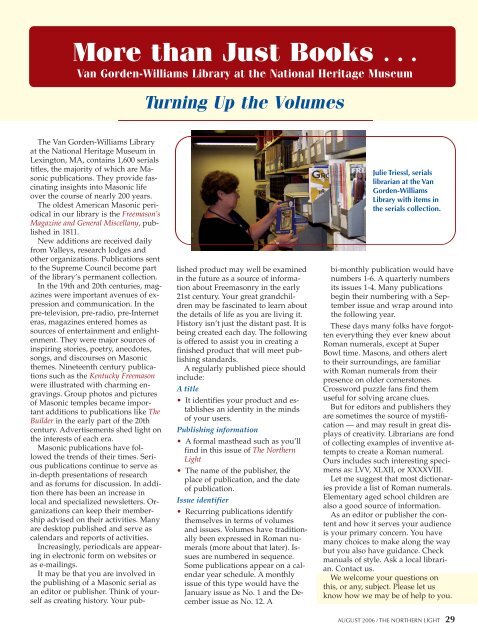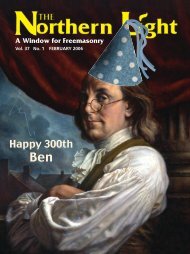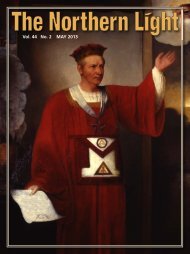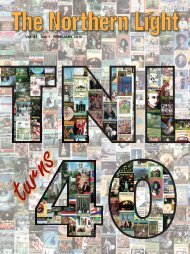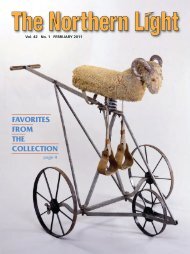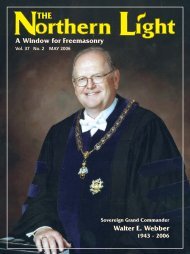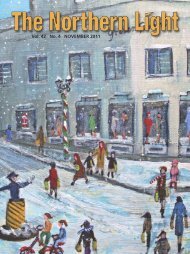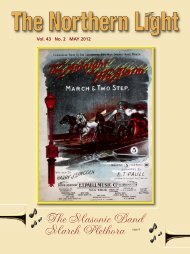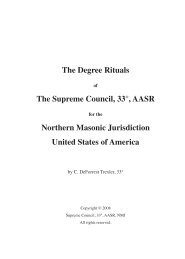A Window for Freemasonry - Scottish Rite
A Window for Freemasonry - Scottish Rite
A Window for Freemasonry - Scottish Rite
Create successful ePaper yourself
Turn your PDF publications into a flip-book with our unique Google optimized e-Paper software.
More than Just Books . . .<br />
Van Gorden-Williams Library at the National Heritage Museum<br />
Turning Up the Volumes<br />
The Van Gorden-Williams Library<br />
at the National Heritage Museum in<br />
Lexington, MA, contains 1,600 serials<br />
titles, the majority of which are Masonic<br />
publications. They provide fascinating<br />
insights into Masonic life<br />
over the course of nearly 200 years.<br />
The oldest American Masonic periodical<br />
in our library is the Freemason’s<br />
Magazine and General Miscellany, published<br />
in 1811.<br />
New additions are received daily<br />
from Valleys, research lodges and<br />
other organizations. Publications sent<br />
to the Supreme Council become part<br />
of the library’s permanent collection.<br />
In the 19th and 20th centuries, magazines<br />
were important avenues of expression<br />
and communication. In the<br />
pre-television, pre-radio, pre-Internet<br />
eras, magazines entered homes as<br />
sources of entertainment and enlightenment.<br />
They were major sources of<br />
inspiring stories, poetry, anecdotes,<br />
songs, and discourses on Masonic<br />
themes. Nineteenth century publications<br />
such as the Kentucky Freemason<br />
were illustrated with charming engravings.<br />
Group photos and pictures<br />
of Masonic temples became important<br />
additions to publications like The<br />
Builder in the early part of the 20th<br />
century. Advertisements shed light on<br />
the interests of each era.<br />
Masonic publications have followed<br />
the trends of their times. Serious<br />
publications continue to serve as<br />
in-depth presentations of research<br />
and as <strong>for</strong>ums <strong>for</strong> discussion. In addition<br />
there has been an increase in<br />
local and specialized newsletters. Organizations<br />
can keep their membership<br />
advised on their activities. Many<br />
are desktop published and serve as<br />
calendars and reports of activities.<br />
Increasingly, periodicals are appearing<br />
in electronic <strong>for</strong>m on websites or<br />
as e-mailings.<br />
It may be that you are involved in<br />
the publishing of a Masonic serial as<br />
an editor or publisher. Think of yourself<br />
as creating history. Your published<br />
product may well be examined<br />
in the future as a source of in<strong>for</strong>mation<br />
about <strong>Freemasonry</strong> in the early<br />
21st century. Your great grandchildren<br />
may be fascinated to learn about<br />
the details of life as you are living it.<br />
History isn’t just the distant past. It is<br />
being created each day. The following<br />
is offered to assist you in creating a<br />
finished product that will meet publishing<br />
standards.<br />
A regularly published piece should<br />
include:<br />
A title<br />
• It identifies your product and establishes<br />
an identity in the minds<br />
of your users.<br />
Publishing in<strong>for</strong>mation<br />
• A <strong>for</strong>mal masthead such as you’ll<br />
find in this issue of The Northern<br />
Light<br />
• The name of the publisher, the<br />
place of publication, and the date<br />
of publication.<br />
Issue identifier<br />
• Recurring publications identify<br />
themselves in terms of volumes<br />
and issues. Volumes have traditionally<br />
been expressed in Roman numerals<br />
(more about that later). Issues<br />
are numbered in sequence.<br />
Some publications appear on a calendar<br />
year schedule. A monthly<br />
issue of this type would have the<br />
January issue as No. 1 and the December<br />
issue as No. 12. A<br />
Julie Triessl, serials<br />
librarian at the Van<br />
Gorden-Williams<br />
Library with items in<br />
the serials collection.<br />
bi-monthly publication would have<br />
numbers 1-6. A quarterly numbers<br />
its issues 1-4. Many publications<br />
begin their numbering with a September<br />
issue and wrap around into<br />
the following year.<br />
These days many folks have <strong>for</strong>gotten<br />
everything they ever knew about<br />
Roman numerals, except at Super<br />
Bowl time. Masons, and others alert<br />
to their surroundings, are familiar<br />
with Roman numerals from their<br />
presence on older cornerstones.<br />
Crossword puzzle fans find them<br />
useful <strong>for</strong> solving arcane clues.<br />
But <strong>for</strong> editors and publishers they<br />
are sometimes the source of mystification<br />
— and may result in great displays<br />
of creativity. Librarians are fond<br />
of collecting examples of inventive attempts<br />
to create a Roman numeral.<br />
Ours includes such interesting specimens<br />
as: LVV, XLXII, or XXXXVIII.<br />
Let me suggest that most dictionaries<br />
provide a list of Roman numerals.<br />
Elementary aged school children are<br />
also a good source of in<strong>for</strong>mation.<br />
As an editor or publisher the content<br />
and how it serves your audience<br />
is your primary concern. You have<br />
many choices to make along the way<br />
but you also have guidance. Check<br />
manuals of style. Ask a local librarian.<br />
Contact us.<br />
We welcome your questions on<br />
this, or any, subject. Please let us<br />
know how we may be of help to you.<br />
AUGUST 2006 / THE NORTHERN LIGHT 29


